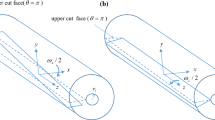Conclusions
-
1.
Introduction of the angular disclinations makes it possible to construct stress fields of a disclination network analytically in anisotropic solids.
-
2.
In the case of a highly anisotropic medium (c 33 ≫ c ij ) the disclination dipole and quadrupole are characterized by the strong dependence of the elastic energy on the dipole arm orientation with respect to the basal plane and on the quadrupole shape correspondingly.
Thus, the investigation carried out in the present study clearly demonstrates the necessity of anisotropic theory of disclinations development. The generalisation of the theory for the case of disclination with arbitrary Frank vector orientation can be done on the basis of rectangular twist disclination loop elastic fields. We intend to solve this problem in the nearest future.
Similar content being viewed by others
References
Lichatchev V. A., Rybin V. V.: Fiz. Tverd. Tela18 (1976) 163.
Vladimirov V. I., Zukovskij I. M.: Fiz. Tverd. Tela17 (1975) 1196.
Zukovskij I. M.: Fiz. Tverd. Tela17 (1975) 969.
Yoffe E. H.: Phil. Mag.5 (1960) 161.
Hirth J. P., Wells R. G.: J. Appl. Phys.41 (1970) 5250.
Lejcek L.: Czech. J. Phys. B28 (1978) 434.
Das E. S. P., Marcinkowski M. J., Armstrong R. W., de Wit R.: Phil. Mag.27 (1973) 369.
Pertsev N. A., Vladimirov V. I.: Czech. J. Phys.B 33 (1983) 28.
de Wit R.: J. Res. Nat. Bur. Standards US77 A (1973) 49.
de Wit R.: J. Res. Nat. Bur. Standards US77 A (1973) 607.
Steeds J. W.: Anisotropic elasticity theory of dislocations. Clarendon Press, Oxford, 1973.
Zukovskij I. M., Rybin V. V.: Fiz. Tverd. Tela18 (1976) 2291.
Vladimirov V. I., Pertsev N. A., Romanov A. E.: Rectangular wedge disclination loops and their interactions with other crystal defects. Preprint PTI N683, Leningrad, 1980.
Odajima A., Maeda T.: J. Polym. Sci. (C) N15 (1966) 55.
Robertson R. E.: J. Polym. Sci. (A2)7 (1969) 1315.
Seto T., Tajima Y.: Japan. J. Appl. Phys.5 (1966) 534.
Attenburrow G. E., Bassett D. C.: J. Mater. Sci.14 (1979) 2679.
Klassen-Neckludova M. V.: Mechanical twinning of crystals. USSR Academy of Sciences, Moscow, 1960.
Author information
Authors and Affiliations
Additional information
The author owes sincere thanks to Professor V. I. Vladimirov for his interest and valuable suggestions in the course of the work and also for reading the manuscript. Thanks are also due to Dr. A. E. Romanov for helpful discussions.
Rights and permissions
About this article
Cite this article
Pertsev, N.A. Disclinations in transversely isotropic media II. Angular and straight disclinations. Czech J Phys 33, 199–207 (1983). https://doi.org/10.1007/BF01605499
Received:
Issue Date:
DOI: https://doi.org/10.1007/BF01605499




